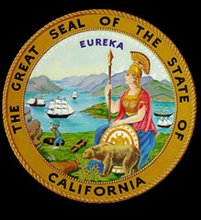
Because Columbia is situated about a mile off of State Route 49, I missed it the first time I drove through. So this time, I thought we would at least stop by and see whats there. Turns out, Columbia is quite the gem! We ended up having a blast and spent the whole day there.

Columbia is situated in the heart of the richest gold mining area of the Mother Lode. The Mother Lode is a region of gold bearing quartz, about one to four miles wide and 120 miles long, which stretches from Georgetown in El Dorado County on the north, through Amador, Calaveras, and Tuolomne counties, south to Mormon Bar in Mariposa county.


A beautiful town, Columbia is unique in many ways to the other mining towns of the Mother Lode. Closed to vehicular traffic, it's tree lined Main Street make for a very tranquil setting. As we explored the shops and exhibits, I could let the kids run around and not worry about them getting hit by cars.

The omnipresent trees seem to have been there throughout the history of the town. They offer a welcome relief from the sun on hot days.


A lively town, Columbia has a variety of shops and activities offering everything from souvenirs, books, handmade candy, chocolates, coffee and other fine confectionery treats, fine dining, family dining, snacks, live theater, old time photos, 1850s era saloons, quilting supplies, museums, period exhibits and displays, costumes, gold panning, stagecoach rides, a gold mine tour, to name some of the fun.

Parkie is impressed, this red wagon is much bigger that his little red wagon at home!

Costumed musicians seem to be on every corner, providing period music that became the soundtrack of our day.


One thing all the mining towns have in common; they've all burned at one time or another. Often more than once. If the town prospered, they rebuilt. If not, the town disappeared into history. Columbia, which burnt at least twice, was very prosperous, so many of the buildings were rebuilt with “fireproof” materials. The red brick and green iron shutters are prevalent with almost all the buildings here.

The mining in Columbia was “dry diggings”. Having no natural streams, only seasonal gulches, water had to be piped in from some 60 miles away and so was not plentiful. Mining was done by building a long sluice and then digging away at the surrounding gold bearing soil and running it through theses sluices.

As a result, at the south end of town the terrain drops about 10 feet because of all the soil being mined away, leaving these formations of rock. These formations create acres of labyrinthine passageways, mazes, caves and tunnels.

These rocks were underground until mining excavated the soil away from around them.

A wonderland for playing a heck of a game of hide-and-seek and tag!


Some of the things to discover in this maze are a gold mine and this miners shack.

This leftover rock turned out to be excellent building material for the town. Today a marble quarry is worked nearby.

These stairs from the town down into the “diggin's” is built with marble from the diggin's.

Parkie takes a closer look at the marble stairs.

The tile floor of the ice cream parlor is made from marble from the diggin's.

Hey wait a minute! Did somebody say “ice cream parlor”?

Ice cream sounds good right about now. I think Rachelle would agree. Like all the buildings in Columbia, the Fallon building has an old timey interior.

The Fallon building in the 1890s.

After a hot day exploring the town and the diggin's, nothing cools and replenishes the spirit like ice cream cones, sundaes and splits.

On the next installment of A California Adventure;
Water up the horses, were going for a ride on the mudwagon!
For more information about Columbia State Historic Park, visit their website:
 This shot could be right out of the 1880s! Well, you know… if our express driver wasn’t talking on his cell phone.
This shot could be right out of the 1880s! Well, you know… if our express driver wasn’t talking on his cell phone. With tickets in hand we boarded the stage.
With tickets in hand we boarded the stage.
 And wouldn’t you know it? Half way through our journey our stage got held up by highway bandits! Those dastardly ne’er-do-wells!
And wouldn’t you know it? Half way through our journey our stage got held up by highway bandits! Those dastardly ne’er-do-wells! I actually feel sorry for these guys. I mean, can you imagine trying to rob this crew?:
I actually feel sorry for these guys. I mean, can you imagine trying to rob this crew?: Well... time to feed the chickens and then hit the road. This ends one awesome day at Columbia. I hope we can find some good BBQ on the way out. I’m a hankerin’ for a good meal.
Well... time to feed the chickens and then hit the road. This ends one awesome day at Columbia. I hope we can find some good BBQ on the way out. I’m a hankerin’ for a good meal.
 Next time on A California Adventure I’m going to post some shots of interesting sights we passed by on our trip home down highway 49. So check back soon (I won’t wait so long to post this time!)!
Next time on A California Adventure I’m going to post some shots of interesting sights we passed by on our trip home down highway 49. So check back soon (I won’t wait so long to post this time!)!








 Parkie is impressed, this red wagon is much bigger that his little red wagon at home!
Parkie is impressed, this red wagon is much bigger that his little red wagon at home!













 Ice cream sounds good right about now. I think Rachelle would agree. Like all the buildings in Columbia, the Fallon building has an old timey interior.
Ice cream sounds good right about now. I think Rachelle would agree. Like all the buildings in Columbia, the Fallon building has an old timey interior.

 On the next installment of A California Adventure;
On the next installment of A California Adventure; 
 After spending hours laboring on a hot day for our $35 worth of gold, we were ready to eat, cool down and relax. And to me, nothing is more relaxing than a slow leisurely ride on an authentic steam train through beautiful scenery .
After spending hours laboring on a hot day for our $35 worth of gold, we were ready to eat, cool down and relax. And to me, nothing is more relaxing than a slow leisurely ride on an authentic steam train through beautiful scenery . So after a hearty lunch, we headed over to the Jamestown train station at the Railtown 1897 state historic park, where I promptly purchased passage from an authentic 1897 ticket agent.
So after a hearty lunch, we headed over to the Jamestown train station at the Railtown 1897 state historic park, where I promptly purchased passage from an authentic 1897 ticket agent. Jamestown was luckier than most gold boom towns in the Sierras in that it never became a ghost town. That was due largely to the fact that in 1897 the Sierra Railroad built into town and Jamestown became a distribution center of goods and services to this region of the Sierra Nevada's.
Jamestown was luckier than most gold boom towns in the Sierras in that it never became a ghost town. That was due largely to the fact that in 1897 the Sierra Railroad built into town and Jamestown became a distribution center of goods and services to this region of the Sierra Nevada's. Ah~ the rumble of the boiler, the bark of the cylinders, the hissing of the steam generator, the deep throaty wail of the whistle, the heavy brass bell, creaky old wooden cars, the scrape of steel wheels on steel rails, all a symphony to my ears.
Ah~ the rumble of the boiler, the bark of the cylinders, the hissing of the steam generator, the deep throaty wail of the whistle, the heavy brass bell, creaky old wooden cars, the scrape of steel wheels on steel rails, all a symphony to my ears.  The Sierra Railroad also established it's shops and roundhouse in Jamestown which, miraculously, has survived all these years along with it's stable of steam locomotives! Gad I love it when history survives.
The Sierra Railroad also established it's shops and roundhouse in Jamestown which, miraculously, has survived all these years along with it's stable of steam locomotives! Gad I love it when history survives. Pretty view! With the symphony of steel going on and scenery rolling by that hasn't changed much in the last 110 years, one gets a rather authentic taste of the old west. Of course sharing the experience with a pretty damsel is always nice.
Pretty view! With the symphony of steel going on and scenery rolling by that hasn't changed much in the last 110 years, one gets a rather authentic taste of the old west. Of course sharing the experience with a pretty damsel is always nice.  I believe two factors contributed to the survival of the historic Sierra Railroad. One, it's remote location. Time stood still here for a Century and resisted the need for modernization. And Two, the railroad and its westerny location was discovered by Hollywood, providing the railroad with the needed extra income to keep it going (also providing an incentive to keep it's historic fleet maintained!).
I believe two factors contributed to the survival of the historic Sierra Railroad. One, it's remote location. Time stood still here for a Century and resisted the need for modernization. And Two, the railroad and its westerny location was discovered by Hollywood, providing the railroad with the needed extra income to keep it going (also providing an incentive to keep it's historic fleet maintained!).  Did I mention that the ride is relaxing?
Did I mention that the ride is relaxing? The Sierra Railway first appeared in movies in Hollywood's 1929 silent film “Virginian”. Since then the railroad has appeared in many movies and television productions. Here are some of its best performances:
The Sierra Railway first appeared in movies in Hollywood's 1929 silent film “Virginian”. Since then the railroad has appeared in many movies and television productions. Here are some of its best performances: TELEVISION
TELEVISION Even big boys have to put away their big toys when they're done playing. Cindy and Parkie watch as our locomotive takes a ride on the turntable and eases into the roundhouse. I didn't notice until now that I almost duplicated the scene of #28, about mid-way in this post, that was taken some 50 years earlier!
Even big boys have to put away their big toys when they're done playing. Cindy and Parkie watch as our locomotive takes a ride on the turntable and eases into the roundhouse. I didn't notice until now that I almost duplicated the scene of #28, about mid-way in this post, that was taken some 50 years earlier! Ghosts of the past. After a good days work (play?) #28 is in it's stall for the night and will be readied for yet another day of pulling passengers through history.
Ghosts of the past. After a good days work (play?) #28 is in it's stall for the night and will be readied for yet another day of pulling passengers through history.



